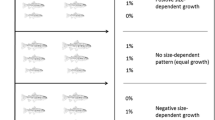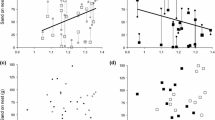Abstract
Male group-living cichlids show status and strategic adjustments in growth, but females appear not to show these growth adjustments. Here, an experimental study in the Lake Tanganyika cichlid Neolamprologus pulcher elaborates on these findings. Females did not show status-dependent growth: (1) Growth in females decelerated with body size but did not depend on social status (breeder or helper), and (2) female helpers did not increase their growth rate after becoming a breeder. Females showed limited evidence for strategic growth: (3) Female helpers did not significantly adjust their growth rate depending on the treatments (comparing female helpers living in groups with a small or a large breeder female); but within the small breeder female treatment, helper growth was significantly related to their body size difference (breeder size–helper size), suggesting a strong non-linear effect of size differences on female helper growth. I conclude that these female cichlids show no status-dependent growth and only strategic growth adjustments when the size difference between the helper female and her breeder female is particularly small.




Similar content being viewed by others
References
Ali M, Nicieza A, Wootton RJ (2003) Compensatory growth in fishes: a response to growth depression. Fish & Fisheries 4:147–190
Aubin-Horth N, Desjardins JK, Martei YM, Balshine S, Hofmann HA (2007) Masculinized dominant females in a cooperatively breeding species. Mol Ecol 16:1349–1358
Awata S, Kohda M (2004) Parental roles and the amount of care in a bi-parental substrate brooding cichlid: the effect of size differences within pairs. Behaviour 141:1135–1149
Awata S, Munehara H, Kohda M (2005) Social system and reproduction of helpers in a cooperatively breeding cichlid fish (Julidochromis ornatus) in Lake Tanganyika: field observations and parentage analyses. Behav Ecol Sociobiol 58:506–516
Awata S, Heg D, Munehara H, Kohda M (2006) Testis size depends on social status and the presence of male helpers in the cooperatively breeding cichlid Julidochromis ornatus. Behav Ecol 17:372–379
Balshine-Earn S, Neat FC, Reid H, Taborsky M (1998) Paying to stay or paying to breed? Field evidence for direct benefits of helping behavior in a cooperatively breeding fish. Behav Ecol 9:432–438
Bender N, Heg D, Hamilton IM, Bachar Z, Taborsky M, Oliveira RF (2006) The relationship between social status, behaviour, growth and steroids in male helpers and breeders of a cooperatively breeding cichlid. Horm Behav 50:173–182
Bergmüller R, Taborsky M (2005) Experimental manipulation of helping in a cooperative breeder: helpers ‘pay to stay’ by pre-emptive appeasement. Anim Behav 69:19–28
Bergmüller R, Heg D, Taborsky M (2005) Helpers in a cooperatively breeding cichlid stay and pay or disperse and breed, depending on ecological constraints. Proc R Soc London B 272:325–331
Brouwer L, Heg D, Taborsky M (2005) Experimental evidence for helper effects in a cooperatively breeding cichlid. Behav Ecol 16:667–673
Buchner AS, Sloman KA, Balshine S (2004) The physiological effects of social status in the cooperatively breeding cichlid Neolamprologus pulcher. J Fish Biol 65:1080–1095
Buston P (2003) Size and growth modification in clownfish. Nature 424:145–146
Buston P (2004) Does the presence of non-breeders enhance the fitness of breeders? An experimental analysis in the clown anemonefish Amphiprion percula. Behav Ecol Sociobiol 57:23–31
Desjardins JK, Hazelden MR, Van Der Kraak GJ, Balshine S (2006) Male and female cooperatively breeding fish provide support for the “Challenge Hypothesis”. Behav Ecol 17:149–154
Desjardins JK, Fitzpatrick JL, Stiver KA, Van Der Kraak GJ, Balshine S (2008a) Costs and benefits of polygyny in the cichlid Neolamprologus pulcher. Anim Behav 75:1771–1779
Desjardins JK, Stiver KA, Fitzpatrick JL, Milligan N, Van Der Kraak GJ, Balshine S (2008b) Sex and status in a cooperative breeding fish: behavior and androgens. Behav Ecol Sociobiol 62:785–794
Dierkes P, Taborsky M, Achmann R (2008) Multiple paternity in the cooperatively breeding fish Neolamprologus pulcher. Behav Ecol Sociobiol 62:1582–1589
Fitzpatrick JL, Desjardins JK, Stiver KA, Montgomerie R, Balshine S (2006) Male reproductive suppression in the cooperatively breeding fish Neolamprologus pulcher. Behav Ecol 17:25–33
Francis RC (1988) Socially mediated variation in growth rate of the midas cichlid: the primacy of early size differences. Anim Behav 36:1844–1845
Fricke H, Fricke S (1977) Monogamy and sex change by aggressive dominance in coral reef fish. Nature 266:830–832
Hamilton IM, Heg D (2007) Clutch-size adjustments and skew models: effects on reproductive partitioning and group stability. Behav Ecol 18:467–476
Hamilton IM, Heg D (2008) Sex differences in the effect of social status on the growth of subordinates in a cooperatively breeding cichlid. J Fish Biol 72:1079–1088
Hamilton IM, Heg D, Bender N (2005) Size differences within a dominance hierarchy influence conflict and help in a cooperatively breeding cichlid. Behaviour 142:1591–1613
Harwood AJ, Armstrong JD, Metcalfe NB, Griffiths SW (2003) Does dominance status correlate with growth in wild stream-dwelling Atlantic salmon (Salmo salar)? Behav Ecol 14:902–908
Heg D (2008) Reproductive suppression in female cooperatively breeding cichlids. Biol Lett 4:606–609
Heg D, Bachar Z (2006) Cooperative breeding in the Lake Tanganyika cichlid Julidochromis ornatus. Environm Biol Fish 76:265–281
Heg D, Hamilton IM (2008) Tug-of-war over reproduction in a cooperatively breeding cichlid. Behav Ecol Sociobiol 62:1249–1257
Heg D, Bachar Z, Brouwer L, Taborsky M (2004a) Predation risk is an ecological constraint for helper dispersal in a cooperatively breeding cichlid. Proc R Soc London B 271:2367–2374
Heg D, Bender N, Hamilton I (2004b) Strategic growth decisions in helper cichlids. Proc R Soc London B 271:S505–S508
Heg D, Bachar Z, Taborsky M (2005a) Cooperative breeding and group structure in the Lake Tanganyika cichlid Neolamprologus savoryi. Ethology 111:1017–1043
Heg D, Brouwer L, Bachar Z, Taborsky M (2005b) Large group size yields group stability in the cooperatively breeding cichlid Neolamprologus pulcher. Behaviour 142:1615–1641
Heg D, Bergmüller R, Bonfils D, Otti O, Bachar Z, Burri R, Heckel G, Taborsky M (2006) Cichlids do not adjust reproductive skew to the availability of independent breeding options. Behav Ecol 17:419–429
Heg D, Jutzeler E, Bonfils D, Mitchell JS (2008) Group composition affects male reproductive partitioning in a cooperatively breeding cichlid. Mol Ecol 17:4359–4370
Heg D, Jutzeler E, Mitchell JS, Hamilton IM (2009) Helpful female subordinate cichlids are more likely to reproduce. PLoS ONE 4:e5458
Hofmann HA, Benson ME, Fernald RD (1999) Social status regulates growth rate: consequences for life-history strategies. Proc N Acad Sci USA 96:14171–14176
Kohda M, Shibata Y, Awata S, Gomagano D, Takeyama T, Hori M, Heg D (2008) Niche differentiation depends on body size in a cichlid fish: a model system of a community structured according to size regularities. J Anim Ecol 77:859–868
Kohler U (1998) Zur Struktur und Evolution des Sozialsystems von Neolamprologus multifasciatus (Cichlidae, Pisces), dem kleinsten Schneckenbuntbarsch des Tanganjikasees. Shaker Verlag, Aachen
Limberger D (1983) Pairs and harems in a cichlid fish, Lamprologus brichardi. Z Tierpsych 62:115–144
Metcalfe NB, Monaghan P (2003) Growth versus lifespan: perspectives from evolutionary ecology. Exp Gerontol 38:935–940
Mitchell JS (2003) Social correlates of reproductive success in false clown anemonefish: subordinate group members do not pay-to-stay. Evol Ecol Res 5:89–104
Munday PL, Cardoni AM, Syms C (2006) Cooperative growth regulation in coral-dwelling fishes. Biol Lett 2:355–358
Nakagawa S, Cuthill IC (2007) Effect size, confidence interval and statistical significance: a practical guide for biologists. Biol Rev 82:591–605
Norusis MJ (2007) SPSS 15.0 advanced statistical procedures companion. Prentice Hall, Upper Sadle River
Royle NJ, Lindstrom J, Metcalfe NB (2005) A poor start in life negatively affects dominance status in adulthood independent of body size in green swordtails Xiphophorus helleri. Proc R Soc London B 272:1917–1922
Schradin C, Lamprecht J (2000) Female-biased immigration and male peace-keeping in groups of the shell-dwelling cichlid fish Neolamprologus multifasciatus. Behav Ecol Sociobiol 48:236–242
Schradin C, Lamprecht J (2002) Causes of female emigration in the group-living cichlid fish Neolamprologus multifasciatus. Ethology 108:237–248
Sloman KA, Gilmour KM, Taylor AC, Metcalfe NB (2000) Physiological effects of dominance hierarchies within groups of brown trout, Salmo trutta, held under simulated natural conditions. Fish Physiol Biochem 22:11–20
Stiver KA, Fitzpatrick J, Desjardins JK, Balshine S (2006) Sex differences in rates of territory joining and inheritance in a cooperatively breeding cichlid fish. Anim Behav 71:449–456
Stiver KA, Fitzpatrick J, Desjardins JK, Balshine S (2009) Mixed parentage in Neolamprologus pulcher groups. J Fish Biol 74:1129–1135
Taborsky M (1984) Broodcare helpers in the cichlid fish Lamprologus brichardi: their costs and benefits. Anim Behav 32:1236–1252
Taborsky M, Limberger D (1981) Helpers in fish. Behav Ecol Sociobiol 8:143–145
Whiteman EA, Cote IM (2004) Dominance hierarchies in group-living cleaning gobies: causes and foraging consequences. Anim Behav 67:239–247
Wong MYL, Buston PM, Munday PL, Jones GP (2007) The threat of punishment enforces peaceful cooperation and stabilizes queues in a coral-reef fish. Proc R Soc London B 274:1093–1099
Wong MYL, Buston PM, Munday PL, Jones GP (2008) Fasting or feasting in a fish social hierarchy. Curr Biol 18:R372–R373
Acknowledgement
I thank R. Schürch and E. Jutzeler for their help, support and discussions throughout this project. I thank the referees for their comments on the manuscript. This study was supported by SNF Grant 3100A0-108473.
Author information
Authors and Affiliations
Corresponding author
Additional information
Communicated by J. Krause
Rights and permissions
About this article
Cite this article
Heg, D. Status-dependent and strategic growth adjustments in female cooperative cichlids. Behav Ecol Sociobiol 64, 1309–1316 (2010). https://doi.org/10.1007/s00265-010-0945-9
Received:
Revised:
Accepted:
Published:
Issue Date:
DOI: https://doi.org/10.1007/s00265-010-0945-9




